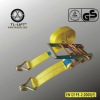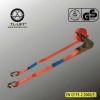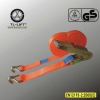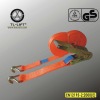- Material Handling Equipment Parts[16]
- Other Hardware[8]
- Hooks[4]
- Screws[8]
- Other Hand Tools[7]
- Scissors[1]
- Motorcycle Motor[6]
- Used Embroidery Machines[6]
- Pulleys[3]
- Clamps[3]
- Hand Carts & Trolleys[1]
- Furniture Legs[2]
- Tape Measures[18]
- Wrench[14]
- Holiday Lighting[2]
- Anchors[6]
- Rivets[1]
- Other Fasteners[2]
- Locks[2]
- Blanket[1]
- Safety Harness[7]
- Safety Belt & Accessories[10]
- Lifting Sling[7]
- Other Tools[7]
- Contact Person : Mr. Zhong yinbiao
- Company Name : Hangzhou TLE Tools Limited
- Tel : 86-571-87353899
- Fax : 86-571-87352233
- Address : Zhejiang,Hangzhou,B1-508 NO.206 ZHENHUA ROAD XIHU DISTRICT HANGZHOU CHINA
- Country/Region : China
- Zip : 310001
GS Polyester Strapping Strap
Polyester Strapping Strap , is designed for material handling purpose. Different end fittings and capacities are available. Belt width from 25mm to 100mm and capacity from 500 daN to 10000 daN. Only trained and authorized persons are permitted to use the cargo lashing.
Caution
l Do not exceed the lashing capacity indicated by the manufacturer! In the case of improper use, the transported articles can not be secured correctly and may cause damages.
l Protect the webbing against sharp edges!
l Examine the wear or damages of the web lashing before each use. If any wear and damages at the webbing or damages at the metal parts, do not use the ratchet tie down any longer.
l Make sure the webbing is fitted without twists and in such a way that may influence the rated lashing capacity, otherwise it may cause damages.
Lash the article
1. Open the ratchet tie down to a proper position for the webbing to be threaded in.
2. Put the webbing around the articles which would be transported and attach hooks to solid anchor points.
3. Thread the free end of webbing (5) through the slotted axis (1) and pull until all slack are removed.
CAUTION: Do not use the slotted axis to take up slack.
4. Pump the handle (3) until reach the degree of tightness you wanted. Be sure there must be at lease 2 1/4 turns on the slotted shaft, but no more than three. (See position A, B and C in Fig. 1). Then swing the handle to the initial secured position A.
CAUTION: Too many layers of webbing will jam ratchet.
5. Now the transported articles are secured!
Release the article
Swing the handle (3) to position D in Fig. 2, pull the latch in handle (2) upward and push the handle forward with a blow force at same time. The tensioning force is released. Now the webbing can be pulled out from the slotted axis (1).
Maintenance and storage
Have the ratchet tie down be checked once a year by an expert. In case of more severe use, it should be checked more often.
The repair of the ratchet tie down must be carried out by the manufacturer or its representatives.
Not keep the ratchet tie down at places with temperatures over 90°C. If the webbing is with visible tears or abrasion, do not use the webbing any longer.
Never keep or dry the webbing in close to the fire or ranges with high temperatures.
Never keep the webbing together with chemical product. If the webbing should have come into contact with chemicals, it must be disposed of immediately.
Information for use and maintenance of web lashing
B.1 In selecting and using web lashings, consideration shall be given to the required lashing capacity, taking into account the mode of use and nature of the load to be secured. The size, shape and weight of the load, together with the intended method of use, transport environment and the nature of the load will affect the correct selection. For stability reasons free-standing units of load have to be secured with a minimum of one pair of web lashings for frictional lashing and two pairs of web lashing for diagonal lashing.
B.2 The selected web lashing shall both be strong enough and of the correct length for the mode of use. Basic lashing rules:
- Plan the fitting and removal operations of lashing before starting a journey;
- Keep in mind that during journeys parts of the load may have to be unloaded;
- Calculate the number of web lashings according to prEN 12195-1:1995;
- Only those web lashings designed for frictional lashing with STF on the label are to be used for frictional lashing;
- Check the tension force periodically, especially shortly after starting the journey.
B.3 Because of different behavior and elongation under load conditions, different lashing equipment (e.g. lashing chain and web lashings) shall not be used to lash the same load. Consideration shall also be given to ancillary fittings (components) and lashing devices in the load restraint assembly are compatible with the web lashing.
B.4 During use flat hooks shall engage over the complete width of the bearing surface of the hook.
B.5 Release of the web lashing: Care should be taken to ensure that the stability of the load is independent of the lashing equipment and that the release of the web lashing shall not cause the load to fall off the vehicle, thus endangering the personnel. If necessary attach lifting equipment for further transport to the load before releasing the tensioning device in order to prevent accidental falling and/or tilting of the load. This applies as well when using tensioning devices which allow controlled removal.
B.6 Before attempting to unload a unit of load its web lashings shall be released so that it can be lifted freely from the load platform.
B.7 During loading and unloading attention has to be paid to proximity of any low overhead power lines.
B.8 The materials from which web lashings are manufactured have a selective resistance to chemical attack.
Seek the advice of the manufacturer or supplier if exposure to chemicals is anticipated. It should be noted that the effects of chemicals may increase with rising temperature. The resistance of man-made fibres to chemicals is summarized below.
Polyamides are virtually immune to the effects of alkalis. However, they are attacked by mineral acids.
Polyester is resistant to mineral acids but is attacked by alkalis.
Polypropylene is little affected by acids and alkalis and is suitable for applications where high resistance to chemicals (other than certain organic solvents) is required.
Solutions of acids or alkalis which are harmless may become sufficiently concentrated by evaporation to cause damage. Take contaminated webbings out of service at once, thoroughly soak them in cold water, and dry naturally.
B.9 Web lashing complying with this Part of EN 12915 are suitable for use in the following temperature ranges:
- 40°C to + 80°C for polypropylene (PP);
- 40°C to + 100°C°C for polyamide (PA);
- 40°C to + 120°C for polyester (PES).
These ranges may vary in a chemical environment. In that case the advice of the manufacturer or supplier shall be sought.
Changing the environmental temperature during transport may affect the forces in the web lashing. Check the tension force after entering warm areas.
B.10 Web lashings shall be rejected or returned to the manufacturer for repair if they show any signs of damage.
The following criteria are considered to be signs of damage:
Only web lashings bearing identification labels shall be repaired;
If there is any accidental contact with chemical products, a web lashing shall be removed from service and the manufacturer of supplier shall be consulted;
For web lashings (to be rejected): tears, cuts, nicks and breaks in load bearing fibres and retaining stitches; deformations resulting from exposure to heat;
For end fittings and tensioning devices: deformations, splits, pronounced signs of wear, signs of corrosion.
B.11 Care should be taken that the web lashing is not damaged by the sharp edges of the load on which it is used.
A visual inspection before and after each use is recommend.
B.12 Only legibly marked and labeled web lashings shall be used.
B.13 Web lashings shall not be overloaded: Only the maximum hand force of 500 N (50 daN on the label; 1 daN= 1 kg) shall be applied. Mechanical aids such as levers, bars etc. as extensions are not to be used unless they are part of the tensioning device.
B.14 Web lashings shall never be used when knotted.
B.15 Damage to labels shall be prevented by keeping them away from sharp edges of the load and, if possible, from the load.
B.16 The webbing shall be protected against friction, abrasion and damage from loads with sharp edges by using protective sleeves and/or corner protectors.
Packing:
Production:
GS Polyester Strapping Strap







